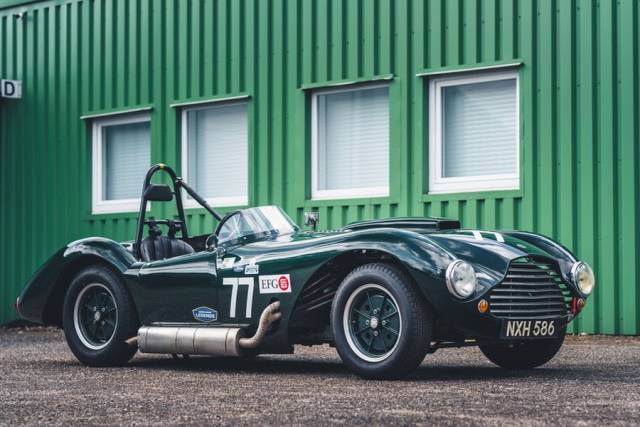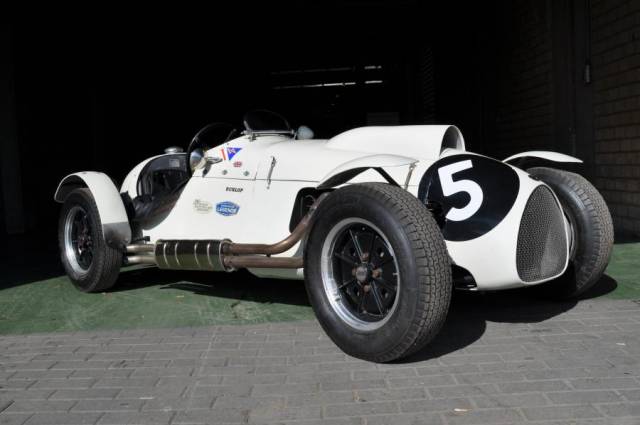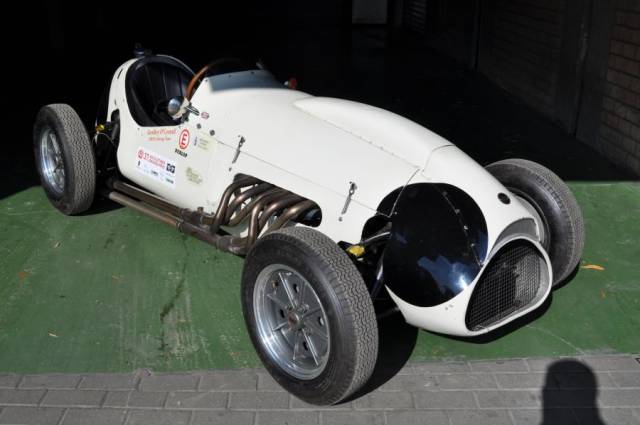Cooper Bristol Oldtimer kaufen
Die Cooper Bristol-Modelle sind Meilensteine des Rennwagenbaus der 1950er Jahre. Durch ihren innovativen Mittelmotoraufbau und kompromisslose Fokussierung auf Leichtbau und Fahrdynamik zählen sie zu den spannendsten Fahrzeugen für historische Motorsport- und Technikliebhaber.
Suchergebnisse
Zur Zeit sind keine passenden Inserate zu Ihrer Suche veröffentlicht.
Benachrichtigung erstellen
Lassen Sie sich benachrichtigen, sobald ein Inserat veröffentlicht wird, das Ihren Suchkriterien entspricht.
Fahrzeug inserieren
Sie haben einen Cooper Bristol, den Sie verkaufen wollen? Dann erstellen Sie jetzt ein Inserat.
Fahrzeug inserieren"Cooper Bristol" Inserats-Referenzen von Classic Trader
Im Folgenden finden Sie Inserate zu Ihrer Suche, die nicht mehr auf Classic Trader verfügbar sind. Für eine bessere Kaufentscheidung können Sie sich mit Hilfe dieser Informationen ein besseres Bild über Verfügbarkeit, Wertentwicklung und aktuellen Preis eines "Cooper Bristol" machen.

1952 | Cooper Cooper-Bristol Mk I
Sport 2 seater

1953 | Cooper Cooper-Bristol Mk II
THE STIRLING MOSS F2 CAR

1952 | Cooper Cooper-Bristol Mk I
Cooper Bristol T20/T25 Mk1

1952 | Cooper Cooper-Bristol Mk I
Cooper Bristol - Sport 2 seater

1953 | Cooper Cooper-Bristol Mk II
T23 MkII single seater F2
Benachrichtigung erstellen
Lassen Sie sich benachrichtigen, sobald ein Inserat veröffentlicht wird, das Ihren Suchkriterien entspricht.
Fahrzeug inserieren
Sie haben einen Cooper Bristol, den Sie verkaufen wollen? Dann erstellen Sie jetzt ein Inserat.
Fahrzeug inserierenGeschichte der Cooper Bristol
Die Cooper Bristol-Modellreihe markiert einen Wendepunkt im Motorsport: Sie war eine der ersten Formelserien, bei der der Motor konsequent hinter dem Fahrer platziert wurde. Die Cooper Car Company, gegründet von Charles und John Cooper, startete zunächst mit 500-ccm-Motorrad-basierten Rennwagen. Erst mit dem Vorschlag, spezielle Leichtmetallmotore von Coventry Climax zu verwenden, gelang der Durchbruch – der Weg zu den charakteristischen, kompakten Mittelmotorrennwagen war frei. Diese Innovation sorgte dafür, dass Cooper-Rennwagen in den 1950er Jahren zu einem festen Bestandteil auf europäischen und internationalen Rennstrecken wurden und den Konstruktionsstil im Motorsport dauerhaft revolutionierten.
Modellgeschichte der Cooper Bristol-Serie
Die Modellreihe startete mit dem Cooper T20, der als einer der ersten professionellen Einsatzwagen des Teams ab 1952 international auftrat. Sein Nachfolger, der T23, feierte ähnliche Erfolge und wurde technisch kontinuierlich weiterentwickelt. Beide Modelle erhielten in Rennkreisen schnell Anerkennung und setzten neue Maßstäbe für Fahrwerk, Motorposition und Handling. Wichtige Fahrerpersönlichkeiten wie Jack Brabham verbanden ihre frühen Karrieren eng mit diesen Kooperationsmodellen, wodurch sich das Renommee der Marke weiter festigte.
Besonderheiten der Cooper Bristol
Die Cooper Bristol-Modelle sind bekannt für ihren besonders leichten Fahrzeugbau und eine konsequente Konzentration auf minimierte Bauhöhe und niedrigen Schwerpunkt – ein klarer Vorteil auf der Rennstrecke. Der innovative Mittelmotoraufbau ermöglichte nicht nur bessere Traktion, sondern auch aerodynamisch vorteilhafte Proportionen. Markant ist zudem die Vielseitigkeit: Von der Teilnahme an internationalen Formel-Rennen bis zu Siegen auf Bergrennstrecken und im historischen Motorsport zeigt sich das breite Einsatzspektrum sehr deutlich.
Technische Daten
Sondermodelle und Sammlervarianten
In begrenzter Stückzahl wurden einzelne T20- und T23-Chassis gezielt für bestimmte Rennen aufgebaut oder von bekannten Privatrennfahrern individualisiert. Insbesondere Wagen mit dokumentierter Renngeschichte und Originalmotorisierung stehen im Fokus von Sammlern und Veranstaltungen wie der Goodwood Revival oder deutschen Historic Masters-Events.
Schwachstellen und typische Problembereiche
Eine häufige Herausforderung bei der Wartung von Cooper Bristol-Modellen ist die Ersatzteilversorgung für die Bristol-Sechszylindermotoren und das spezifische Transaxle-Getriebe. Wagen, die im harten historischen Renneinsatz standen, zeigen oft Verschleiß an den Radaufhängungen sowie typische Schwächen bei originalen Magnesium-Komponenten. Fachkundige Inspektionen insbesondere an Motor und Fahrwerk sind vor dem Erwerb empfehlenswert.
Motorisierung, Getriebe und Fahreigenschaften
Die Cooper Bristol stehen für ein sehr direktes, unverfälschtes Fahrerlebnis. Durch geringe Fahrzeugmassen in Kombination mit kräftigen Sechszylindern und handgeschalteten Getrieben ist viel fahrerisches Können gefragt, um das Potenzial auf der Rennstrecke auszuschöpfen. Die Lenkung reagiert präzise, die Bremsen und Achskonstruktionen sind kompromisslos auf Sporteinsatz ausgelegt.
- Cooper T20: Das Basismodell der Bristol-Serie mit verbreitetster Stückzahl und hoher Nachfrage in historischen Rennserien.
- Cooper T23: Weiterentwickelte Version mit Detailverbesserungen, selten angeboten, aber auf historischen Events gefragt.
Design, Interieur und Ausstattung
Durch die Verwendung eines filigranen Gitterrohrrahmens, kompakter Alukarosserie und puristischen Cockpits gelingt es den Cooper Bristol-Modellen, maximale Leichtigkeit und Funktion auf engstem Raum zu verbinden. Der Innenraum ist auf das nötigste reduziert und bietet Rennatmosphäre pur. Die geringe Bauhöhe und markanten offenen Radausschnitte betonen die sportlichen Proportionen. Viele Exemplare präsentieren sich im klassischen British Racing Green oder mit individuell gestalteten Startnummern und Lackierungen aus ihrer Renngeschichte. Sonderzubehör wie historische Stoppuhren, original Lederlenkräder oder periodenspezifische Felgen machen jedes Exemplar zu einem echten Unikat.
Weitere Besonderheiten
Viele Cooper Bristol wurden nach ihrer Einsatzzeit im internationalen Motorsport für nationale Cup-Serien oder Bergrennen umgebaut und stehen heute als Zeitzeugen der Rennsporttechnologie der 1950er Jahre bei historischen Veranstaltungen im Rampenlicht. Die lückenlose Dokumentation von Chassisnummern und Renneinsätzen ist ein wichtiger Aspekt für Sammler.
Zusammenfassung
Die Cooper Bristol-Modelle verkörpern Innovationskraft, technischen Fortschritt und die kompromisslose Fokussierung auf Motorsport. Wer einen echten Vertreter der britischen Rennwagenkultur mit klarer Herkunft sucht, findet bei diesen Fahrzeugen sowohl eine spannende Werkstatt für Technikenthusiasten als auch ein exklusives Investment für den historischen Rennsport.